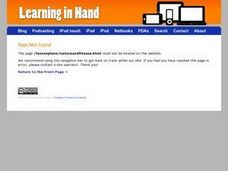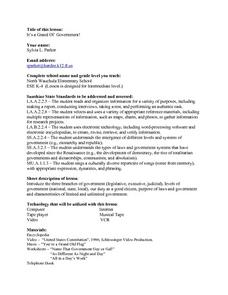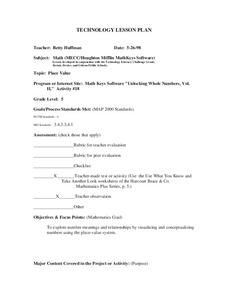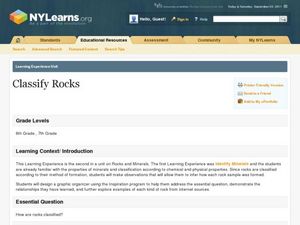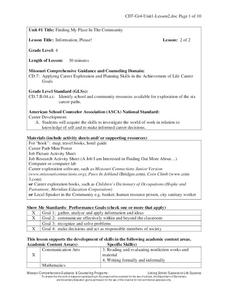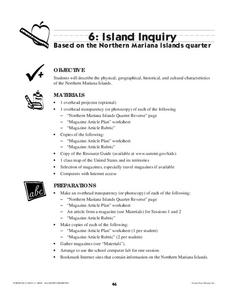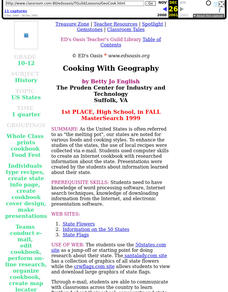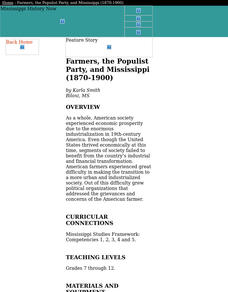Curated OER
We're Batty
Young scholars watch a video about bats and compare and contrast them to birds. They identify the specific characteristics that identify bats as mammals and what makes them unique from other mammals.
Curated OER
The Search for Secret Agents
Young scholars embark on a scavenger hunt around the school looking for indoor air pollution and mapping source locations. They predict and observe sources of indoor air pollution, understand and give examples of technologies we use...
Curated OER
Nature and Fintess Trail
Students investigate how humans impact the environment and compile an organism database into an e-book field guide. They name muscle groups and develop specific exercises to strengthen these groups. Students utilize technology for data...
Curated OER
It's a Grand Ol' Government!
Students discuss the three branches of government and the different levels. They talk about the purpose of laws and use the Internet to locate information about governments. They watch the video, "United States Constitution" and look up...
Curated OER
MathKeys Software "Unlocking Whole Numbers, Vol. 11(Place Value for Four Digit Numbers)"
Third graders explore the place values of four digit numbers by writing four digit numbers and examining the effects of rearranging the numbers' digits. They practice making their four digit number with base-ten blocks then rearrange the...
Curated OER
Place Value
Fifth graders explore number meanings and their relationship. Using place value clues and base-ten blocks, 5th graders build a models of numbers and determine their value. To reinforce number relationship, students participate in a...
Curated OER
Building Numbers
Fifth graders use place value clues to find a given number. In this place value lesson plan, 5th graders work with the MathKeys program using place value clues and base-ten blocks to build a number and determine its value.
Curated OER
Water: H2O = Life
In this earth science worksheet, students explore and describe animals and their adaptations, including their habitats, physical characteristics, and competing organisms. They also explore and describe how others use water around the...
Curated OER
Classify Rocks
Students classify different types of rocks. In this earth science lesson plan, students test different rock samples and construct a chart to record observations. They create a concept map that answers essential questions.
Curated OER
Japan
Students locate Japan's absolute and relative location on a globe and various maps. They describe Japan's various regions and islands and their system of education, customs and religion. They assess Japan's impact on our society.
Curated OER
A Digital Family Tree Trip Through Time
Students research their family history by creating a family tree and using online tools. In this family tree lesson, students use bubbl.us to research their biographical information and web the data. Students create timelines for their...
Curated OER
Colorado Greats Trading Cards
Students research to find information about famous people from Colorado. They copy and save pictures from the Internet, then make a trading card containing important biographical data.
Curated OER
Treasure of the Tar
High schoolers, using an atlas, locate the region known as the "Tar Sands" in the Central Plains of Canada. They hypothesize about the future economic potential of this natural resource. They create a poster about the Tar Sands industry...
Curated OER
Seafloor Block Model
Students construct a 3-D block model of the ocean floor to study fundamental earth processes. This is a preconstructed cut out that allows the students to put it together but then to add their own colors as well. There is an evaluation...
Curated OER
Explorers (Early European)
Students research and explore the past and its historical roots involving the economic motivations of early European explorers. They assess connections between the current technological advances in transportation and that of the early...
Curated OER
Solar System: The Four Inner Planets and Earth's Moon and Astronauts
Second graders read THe Magic School Bus: Lost in the Solar System. In this language arts and science lesson, 2nd graders explore the four inner planets. Students view the inner planets using Google Earth.
Curated OER
Information, Please!
Fourth graders research jobs by using different software programs. In this researching jobs lesson plan, 4th graders conduct a Webquest in order to see what they need to do to complete certain jobs.
Curated OER
Island Inquiry: Based on the Northern Mariana Islands Quarter
Students research two physical and/or human characteristic topics of the Northern Mariana Islands in groups of four students. In this social studies lesson, students analyze how to write magazine articles and research the two topics...
Curated OER
Cooking With Geography
Sstudents use desktop publishing to create "real world" documents from information received from collaborating classes. They create an electronic presentation from Internet research. They experience foods from different states and regions.
Curated OER
Why Thank You!
Fifth graders listen to a read aloud of Patricia Polacco's, Thank You, Mr. Falker! students examine the use of voice in the book, discuss the writing and theme ideas. They write a thank you not to their hero.
Curated OER
Structure of the Earth
Sixth graders investigate earthquakes and volcanoes. They demonstrate fault lines with a folded piece of paper, conduct an erosion experiment, and construct a volcano using clay, baking soda and vinegar.
Alabama Learning Exchange
Is My Water Safe?
Learners discuss what makes their drinking water safe and unsafe. They locate and visit a local tributary and test the water's pH, hardness, dissolved oxygen, and total alkalinity. They compose a summary paragraph about the tests and...
Curated OER
America and Texas: Where's The Symbol?
Students explore the flags of the United States and the state of Texas. They identify the flags using PowerPoint. Students use location words to drag symbols to the correct location.
Curated OER
Farmers, the Populist Party, and Mississippi (1870-1900)
Students determine the cause and effect of a historical event. They draw conclusions about statistical data and maps and compose a campaign speech for a Populist candidate. They design a political poster and badge for the Populist Party.


